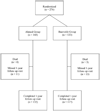Treatment outcomes in the Ahmed Baerveldt Comparison Study after 1 year of follow-up
- PMID: 20932583
- PMCID: PMC3020266
- DOI: 10.1016/j.ophtha.2010.07.016
Treatment outcomes in the Ahmed Baerveldt Comparison Study after 1 year of follow-up
Abstract
Purpose: To determine the relative efficacy and complications of the Ahmed glaucoma valve (AGV) model FP7 (New World Medical, Ranchos Cucamonga, CA) and the Baerveldt glaucoma implant (BGI) model 101-350 (Abbott Medical Optics, Abbott Park, IL) in refractory glaucoma.
Design: Multicenter, randomized, controlled clinical trial.
Participants: Two hundred seventy-six patients, including 143 in the AGV group and 133 in the BGI group.
Methods: Patients 18 to 85 years of age with refractory glaucoma having intraocular pressure (IOP) of 18 mmHg or more in whom an aqueous shunt was planned were randomized to undergo implantation of either an AGV or a BGI.
Main outcome measures: The primary outcome was failure, defined as IOP >21 mmHg or not reduced by 20% from baseline, IOP ≤5 mmHg, reoperation for glaucoma or removal of implant, or loss of light perception vision. Secondary outcomes included mean IOP, visual acuity, use of supplemental medical therapy, and complications.
Results: Preoperative IOP (mean±standard deviation [SD]) was 31.2±11.2 mmHg in the AGV group and 31.8±12.5 mmHg in the BGI group (P = 0.71). At 1 year, mean±SD IOP was 15.4±5.5 mmHg in the AGV group and 13.2±6.8 mmHg in the BGI group (P = 0.007). The mean±SD number of glaucoma medications was 1.8±1.3 in the AGV group and 1.5±1.4 in the BGI group (P = 0.071). The cumulative probability of failure was 16.4% (standard error [SE], 3.1%) in the AGV group and 14.0% (SE, 3.1%) in the BGI group at 1 year (P = 0.52). More patients experienced early postoperative complications in the BGI group (n = 77; 58%) compared with the AGV group (n = 61; 43%; P = 0.016). Serious postoperative complications associated with reoperation, vision loss of ≥2 Snellen lines, or both occurred in 29 patients (20%) in the AGV group and in 45 patients (34%) in the BGI group (P = 0.014).
Conclusions: Although the average IOP after 1 year was slightly higher in patients who received an AGV, there were fewer early and serious postoperative complications associated with the use of the AGV than the BGI.
Copyright © 2011 American Academy of Ophthalmology. Published by Elsevier Inc. All rights reserved.
Figures




Comment in
-
Glaucoma surgery: as easy as ABC?Ophthalmology. 2011 Mar;118(3):433-4. doi: 10.1016/j.ophtha.2011.01.042. Ophthalmology. 2011. PMID: 21376241 No abstract available.
References
-
- Ramulu P, Corcoran KJ, Corcoran SL, Robin AL. Utilization of various glaucoma surgeries and procedures in Medicare beneficiaries from 1995 to 2004. Ophthalmology. 2007;114:2265–2270. - PubMed
-
- Chen PP, Yamamoto T, Sawada A, et al. Use of antifibrosis agents and glaucoma drainage devices in the American and Japanese Glaucoma Societies. J Glaucoma. 1997;6:192–196. - PubMed
-
- Joshi AB, Parrish RK, II, Feuer WF. 2002 Survey of the American Glaucoma Society: practice preferences for glaucoma surgery and antifibrotic use. J Glaucoma. 2005;14:172–174. - PubMed
-
- Gedde SJ, Schiffman JC, Feuer WJ, et al. Tube Versus Trabeculectomy Study Group. Treatment outcomes in the Tube Versus Trabeculectomy Study after one year of follow-up. Am J Ophthalmol. 2007;143:9–22. - PubMed
-
- Gedde SJ, Herndon LW, Brandt JD, et al. Tube Versus Trabeculectomy Study Group. Surgical complications in the Tube Versus Trabeculectomy Study during the first year of follow-up. Am J Ophthalmol. 2007;143:23–31. - PubMed
Publication types
MeSH terms
Grants and funding
LinkOut - more resources
Full Text Sources
Medical

